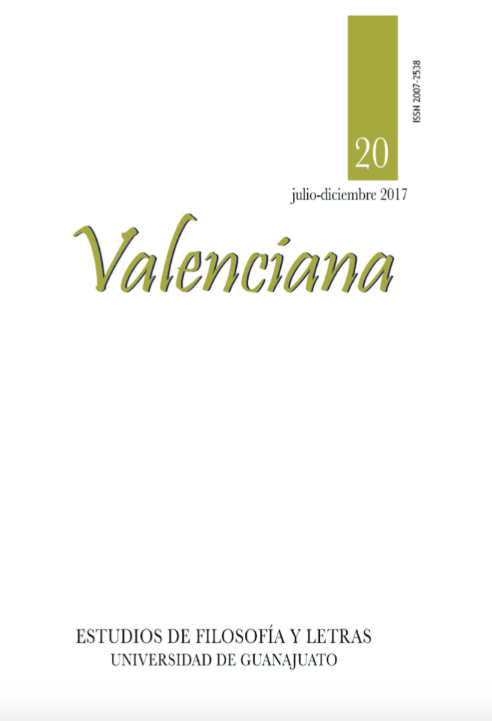Central American narrative: border, violence and exile. Notes for a chronicle of corruption
DOI:
https://doi.org/10.15174/rv.v0i20.292Abstract
Central America has been a fertile ground for the consolidation of a literature linked to conflicts of identity that frame a number of other social and political problems. Despite the fact of being part of a region that bears a similarity in the natural and anthropological wealth, it is clear that there is a collective effort to point out the ideological and cultural differences between the region. The article to expose how these cleavages are built as discursive boundaries that keep in line the fraternity and go in depth the gaps that are form between the border areas of these nations as related by factors beyond the geographical coincidence.References
Aguayo, Sergio. El éxodo centroamericano. Consecuencias de un conflicto. México: SEP, 1985.
Aguilera-Malta, Demetrio, 1977: Canal Zone, Joaquín Mortiz. México.
Arias, Arturo, 2000, “Bocado de viento” en Cuentos centroamericanos (Comp. Poli Délano), Editorial Andrés Bello, Barcelona. Pp. 15-42.
Arroyo, Justo, 2010, “La pregunta” en El cuento hispanoamericano (Ant. Seymour Menton), décima edición, FCE, Colección Popular, México. Pp. 731-735.
Bahr, Eduardo, 2000, “Los héroes de la fiebre”, en Cuentos centroamericanos (Comp. Poli Délano), Editorial Andrés Bello, Barcelona. pp. 69-78.
Castellanos Moya, Horacio, 2001, El arma en el hombre, Tusquets, México.
Castillo, Manuel Ángel, 1998, “La política de inmigración en México: Un breve recuento”, en Manuel Ángel Castillo et al. (coord.), Migración y fronteras, El Colegio de la Frontera Norte-El Colegio de México-Asociación Latinoamericana de Sociología, México. Pp. 425-451.
Chamorro Cardenal, Pedro Joaquín, 1957, Estirpe sangrienta: los Somoza, México, Patria y Libertad, México.
Chávez Alfaro, Lizandro, 2000, “El zoológico de papá”, en Cuentos centroamericanos (Comp. Poli Délano), Editorial Andrés Bello, Barcelona. Pp. 143-148.
Cuevas Velasco, Norma Angélica y Raquel Velasco González (Coordinación y edición) El norte y el sur de México en la diversidad de su literatura. Juan Pablos Editor/ RITELI, 2011, México.
Délano, Poli, 2000, Cuentos centroamericanos. Editorial Andrés Bello, Barcelona.
García de la Sienra, Rodrigo y Raquel Velasco (Coord., y ed.) La migración y sus narraciones, USA, Literal Publishing, 2014.
Menton, Seymour, 2010, El cuento hispanoamericano. FCE, México.
Palacios, Oscar, 1993, La mitad del infierno. Gobierno del Estado de Chiapas / Consejo Estatal de Fomento a la Investigación y Difusión de la Cultura / DIF-Chiapas / Instituto Chiapaneco de la Cultura, Chiapas, México.
Pantxika Cazaux, 1983, “Guatemala hoy” en Casa del tiempo, no. 31 y 32, vol. III, UAM, México. Pp 29-35.
Portal: http://www.onwar.com/aced/data/sierra/soccer1969.htm consultado 10 de octubre de 2011.
Portal: http://www.latinamericanstudies.org/nicaragua.htm. 13 de agosto de 2016.
Rey Rosa, Rodrigo, 2001, Piedras encantadas. Seix Barral, España.
Santos-Febres, Mayra, 2006, Nuestra Señora de la noche. Espasa-Calpe, Madrid.
Simonovis, Leonora, 2010. “Isabel Luberza Oppenheimer: variaciones de una misma plena” [documento pdf]. Consultado el 8 de noviembre de 2011. http://dialnet.unirioja.es/servlet/articulo?codigo=3304201.
Vadillo Buenfil, Carlos, 2004, Te están buscando, Editorial Arguval, Málaga.
Published
How to Cite
Issue
Section
License
Author(s) who publish in this journal do accept the next conditions:
According to copyright regulations, Valenciana does recognize and respect the authors’ moral right, as well as the right of property, which will be assigned to the journal for its diffusion in open access.
Valenciana does not charge authors for the submission, editorial process or publication in the journal.
All texts published and distributed by Valenciana (without exception) are supported by the license Creative Commons Attribution-NonCommercial 4.0 International (CC BY-NC 4.0), which allows third parties to use the publication as long as they mention the author and the first publication.
Authors can make other independent and additional contractual agreements for the non-exclusive use of his article published in Valenciana (e.g. including it in an institutional repository or in printed/electronic media), as long as it is explicitly clarified that the article was published for the first time in this journal.
For these purposes, authors must sign and send the letter of submission and copyright transfer form in a PDF file to this email address: revistavalenciana@gmail.com
This journal is under a license by Creative Commons Atribución-NoComercial-SinDerivadas 4.0 Internacional (CC BY-NC-ND 4.0)).











